Woodlawn Cemetery (Bronx, New York)
|
Woodlawn Cemetery | |
|
Main office building | |
   | |
| Location |
Webster Avenue and East 233rd Street Woodlawn, Bronx, The Bronx |
|---|---|
| Coordinates | 40°53′21″N 73°52′24″W / 40.88917°N 73.87333°WCoordinates: 40°53′21″N 73°52′24″W / 40.88917°N 73.87333°W |
| NRHP reference # | 11000563 |
| Significant dates | |
| Added to NRHP | June 23, 2011 |
| Designated NHL | June 23, 2011 |
Woodlawn Cemetery is one of the largest cemeteries in New York City and a designated National Historic Landmark. Located in Woodlawn, Bronx, New York City, it has the character of a rural cemetery. Woodlawn Cemetery opened during the Civil War in 1863,[1] in what was then southern Westchester County, in an area that was annexed to New York City in 1874.[2] It is notable in part as the final resting place of some great figures in the American arts, such as authors Countee Cullen, Nellie Bly, and Herman Melville, and musicians Irving Berlin, Miles Davis, Duke Ellington, W. C. Handy, and Max Roach.[3][4] Holly Woodlawn, after changing her name to such, falsely told people she was the heiress to Woodlawn Cemetery.
Locale and grounds
The Cemetery covers more than 400 acres (160 ha)[1] and is the resting place for more than 300,000 people. Built on rolling hills, its tree-lined roads lead to some unique memorials, some designed by famous American architects: McKim, Mead & White, John Russell Pope, James Gamble Rogers, Cass Gilbert, Carrère and Hastings, Sir Edwin Lutyens, Beatrix Jones Farrand, and John La Farge. The cemetery contains seven Commonwealth war graves – six British and Canadian servicemen of World War I and an airman of the Royal Canadian Air Force of World War II.[5] In 2011, Woodlawn Cemetery was designated a National Historic Landmark, since it shows the transition from the rural cemetery popular at the time of its establishment to the more orderly 20th-century cemetery style.[6]
As of 2007, plot prices at Woodlawn were reported as $200 per square foot, $4,800 for a gravesite for two, and up to $1.5 million for land to build a family mausoleum.[7]
Burials moved to Woodlawn
Woodlawn was the destination for many human remains disinterred from cemeteries in more densely populated parts of New York City:[8]
- Rutgers Street church graves were moved to Woodlawn. Most graves were re-interred with a stated date of December 20, 1866 into the Rutgers Plot, lots 147-170.
- West Farms Dutch Reformed Church, at Boone Avenue and 172nd Street in The Bronx, had most of its graves moved to Woodlawn Cemetery in 1867 and interred in the Rutgers Plot, Lots 214-221.
- Bensonia Cemetery, also known as "Morrisania Cemetery", was originally a Native American burial ground. The graves were moved to Woodlawn Cemetery with a stated date of April 21, 1871 and re-interred into Lot 3. Public School #138, in The Bronx, is now on the site.
- Harlem Church Yard cemetery internees were moved to Woodlawn. Most graves were re-interred with a stated date of August 1, 1871 into the Sycamore Plot, lots 1061–1080.
- Nagle Cemetery remains were moved in November–December 1926 and reinterred in Primrose Plot, Lot 16150. Identities of those interred are apparently unknown.
- The Dyckman-Nagle Burying Ground,[9] West 212th Street at 9th Avenue, in the Borough of Manhattan, was originally established in 1677 and originally contained 417 plots. In 1905, the remains, with the exception of Staats Morris Dyckman[10] and his family, were removed. By 1927, the Dyckman graves were finally moved to Woodlawn Cemetery. The former Dutch colonial-era cemetery is now a 207th Street subway train yard.
The fictional cemetery of the Synagogue in Brooklyn in the film Once Upon a Time in America is actually located here, renamed "Riverdale Cemetery".[11]
Notable burials
A
- Charles H. Adams, politician
- Anthony Allaire
- Vivian Beaumont Allen
- Vincent Alo
- Anastasia, Princess of Greece and Denmark buried with her parents in the family mausoleum.
- John Murray Anderson
- Alexander Archipenko
- Herman Ossian Armour
- Hugh D. Auchincloss
- James C. Auchincloss
B
- Benjamin Babbitt
- Jules Bache
- James Anthony Bailey
- Joseph C. Baldwin
- Billy Bang
- Frances Elizabeth Barrow
- Diana Barrymore
- Nora Bayes
- Charles Becker
- Digby Bell
- Laura Joyce Bell
- Alva Belmont
- Oliver Belmont
- Irving Berlin, songwriter, musician, and bandleader
- Maximilian Berlitz
- Samuel Rossiter Betts
- Amelia Bingham
- Ausburn Birdsall
- Elizabeth Bisland
- Cornelius Bliss
- Nellie Bly
- Coralie Blythe
- George Boldt
- Robert W. Bonynge
- Emma Booth, involved with the Salvation Army
- Gail Borden
- Bostwick family
- Anne Lynch Botta
- William V. Brady, Mayor of New York City
- Boris Brasol
- Herbert Brenon
- Bricktop
- Benjamin Bristow
- Addison Brown
- Henry Bruckner, Bronx Borough President
- Charles Waldron Buckley
- Ralph Bunche, United Nations official and diplomat
- Richard Busteed
- Benjamin Franklin Butler (1795-1858), lawyer
- Charles Butler
C
- Hervey C. Calkin
- Harry Carey
- Charles A. Carleton
- Vernon and Irene Castle, well-known husband & wife dancing team, movie stars
- Carrie Chapman Catt
- Alfred Chapin
- John Wilbur Chapman, Evangelist, Author, Hymn Writer
- Robert Chesebrough
- Joseph Hodges Choate, lawyer, diplomat
- Bobby Clark (comedian)
- Horace F. Clark
- Huguette Clark
- William A. Clark
- Henry Clews
- Elizabeth Jane Cochran
- George M. Cohan - bronze statue in center of Times Square
- Barron Collier
- Ida Conquest
- Austin Corbin
- Ricardo Cortez
- Lotta Crabtree
- William Nelson Cromwell
- Celia Cruz[12]
- Countee Cullen
- Frederick Kingsbury Curtis
D
- Leopold Damrosch
- Jess Dandy
- Miles Davis[12]
- Clarence Day
- Zachariah Deas
- Cornelius H. DeLamater
- George Washington De Long
- Rafael Díez de la Cortina y Olaeta, linguist
- Sidney Dillon
- E.L. Doctorow
- Charles Cleveland Dodge, Brigadier General (youngest), American Civil War
- William E. Dodge
- Richard Dorson
- Paul Du Chaillu
- Vernon Duke
- Finley Peter Dunne
- William C. Durant
E
- Gertrude Ederle, record-setting swimmer
- Gus Edwards
- Duke Ellington[12]
- Albert Ellis
F
G
- Tommy Gagliano
- Lindley Miller Garrison
- Francis Patrick Garvan
- John Warne Gates
- Charles Sidney Gilpin
- Thomas F. Gilroy, Mayor of New York City
- Ambrosio José Gonzales
- Jay Gould
- Archibald Gracie
- Archibald Gracie III, Confederate General
- Archibald Gracie IV, Titanic survivor
- Charles K. Graham, Union General & Civil Engineer
- George Bird Grinnell, anthropologist, historian, naturalist, and writer.
- Lawrence Grossmith, English actor
- Simon Guggenheim
H
- Oscar Hammerstein, Sr.
- Lionel Hampton
- W. C. Handy
- Edward Harkness, philanthropist
- Lamon V. Harkness, businessman, stockholder in Standard Oil, yachtsman
- William L. Harkness
- Charles K. Harris
- William Frederick Havemeyer, businessman, Mayor of New York City
- Coleman Hawkins
- Millicent Hearst
- August Heckscher
- John Held, Jr.
- Victor Herbert
- Adelaide Herrmann
- Alexander Herrmann
- Christian Archibald Herter
- John D. Hertz, businessman, thoroughbred racehorse owner and breeder
- Jim Holdsworth, baseball player
- Richard Hudnut
- Charles Evans Hughes, 11th Chief Justice of the United States
- Harold Hunter, skateboarder
- Arabella Huntington
- Collis P. Huntington
- Barbara Hutton
- Henry Baldwin Hyde
J
K
L
- Fiorello La Guardia
- Scott La Rock
- Daniel S. Lamont
- Walter W. Law
- Canada Lee
- Henry Lehman
- Frank Leslie
- J. C. Leyendecker, illustrator
- Harold Lockwood
- Frank Belknap Long
- Mansfield Lovell, Confederate officer
- August Guido Lüchow, restaurateur
- George Platt Lynes
M
- Rowland Macy
- Frankie Manning, dancer, instructor, and choreographer
- Martha Mansfield
- Vito Marcantonio, politician
- Dewey Markham
- Alfred Erskine Marling
- Louis Marx, toy merchant
- Bat Masterson, lawman, writer
- Victor Maurel
- William McAdoo
- Josiah Calvin McCracken
- George A. McGuire
- Jackie McLean, musician
- George McManus, cartoonist
- Roi Cooper Megrue, playwright
- Marie Mattingly Meloney
- Herman Melville, author
- Dean Meminger
- Mario Merola (1922–1987), lawyer, New York City Councilman, and Bronx County District Attorney
- William P. Merrill
- Cyrus Miller, lacrosse player
- Gilbert Miller
- Marilyn Miller
- Florence Mills
- John Purroy Mitchel, Mayor of New York City
- John Bassett Moore
- Paul Morton
- Robert Moses, government official, planner, builder, and Parks Department Commissioner of New York City
N
- Thomas Nast, political cartoonist
- LeRoy Neiman, artist
- Harold Nicholas
- Ruth Rowland Nichols
- Hideyo Noguchi
- James W. Nye
O
P
- Augustus G. Paine, Jr.
- Felix Pappalardi
- James Cash Penney
- Antoinette Perry, actress, director and co-founder of the American Theatre Wing
- Alex Pompez, African-American baseball executive
- Generoso Pope
- George B. Post
- Otto Preminger, film director
- Samuel I. Prime
- Frederick Freeman Proctor, vaudeville impresario
- Joseph Pulitzer, newspaper owner and founder of Pulitzer prize
- Mihajlo Pupin
R
- Charles Ranhofer
- Norman B. Ream[13][14]
- Theodor Reik
- Gaetano Reina
- Lance Reventlow
- Grantland Rice
- Vincent Richards
- Tex Rickard
- Max Roach
- Delmar "Barney" Roos
- Margaret Rudkin, Pepperidge Farm founder
- Dick Rudolph, major league baseball pitcher, one of 17 who was allowed to continue to throw the spitball after baseball made against the rules in 1920
- Damon Runyon
S
- Ruth Brown Snyder
- Elizabeth Cady Stanton, early women's rights activist
- Josef Stránský, Czech conductor, composer, and art collector
- Ida Straus
- Isidor Straus- owner of Macy's Department Store, Democratic member of the 53rd Congress of the United States, victim of the sinking of the RMS Titanic
- William Lafayette Strong, Mayor of New York City
- William Matheus Sullivan, prominent New York City lawyer and patron of music
- Karl Struss
T
- Arthur Fitzwilliam Tait, artist
- Jokichi Takamine
- Clarice Taylor
- Jerry Thomas, bartender
- Olive Thomas
- Lloyd Tilghman, Confederate General
- Dan Topping
- Henry Tremain, Union Brevet Brigadier General
U
V
- Abraham Van Buren
- Robert Anderson Van Wyck, first Mayor of Greater New York City
- Virginia Fair Vanderbilt
W
Image gallery
 Annie Bliss Titanic memorial
Annie Bliss Titanic memorial Richard Hudnut Monument
Richard Hudnut Monument Van Cortlandt frieze (Robert Moses)
Van Cortlandt frieze (Robert Moses)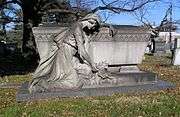 Sarcophagus with angel
Sarcophagus with angel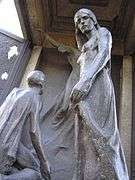 Dishabille statue
Dishabille statue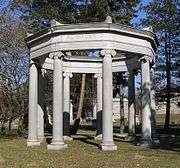 Reisinger Monument
Reisinger Monument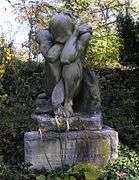 Nathan Piccirilli Monument
Nathan Piccirilli Monument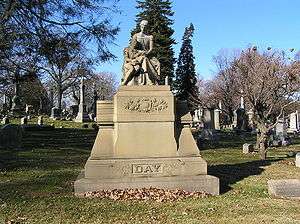 The monument of Clarence Day
The monument of Clarence Day Joe "King" Oliver's grave
Joe "King" Oliver's grave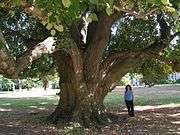
 White Oak Tree
White Oak Tree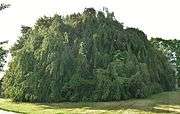
- Woolworth's tomb
See also
References
- 1 2 "A National Historic Landmark". The Woodlawn Cemetery. Retrieved November 17, 2013.
- ↑ Jackson, Kenneth T. (1995). Encyclopedia of the City of New York. New Haven & New York: Yale University Press.
- ↑ "Notable People". Woodlawn Cemetery. Retrieved April 4, 2015.
- ↑ Cooper, Rebecca (March 14, 2003). "Neighborhoods: Close-Up on Woodlawn". Village Voice. Archived from the original on June 20, 2006.
- ↑ "Find War Dead" Commonwealth War Graves Commission. WGC Cemetery Report. Retrieved November 17, 2013.
- ↑ "National Register of Historic Places listings; July 22, 2011". National Park Service. July 22, 2011. Retrieved July 25, 2011.
- ↑ Tom Van Riper, America's Most Expensive Cemeteries, Forbes.com, October 26, 2007
- ↑ Inskeep, Carolee (1998). The Graveyard Shift: A Family Historian's Guide to New York City Cemeteries. Ancestry Publishing. p. xii. ISBN 0-916489-89-2.
- ↑ "Forgotten Cemeteries of Inwood".
- ↑ "Staats/States Dyckman biography". New York State Museum.
- ↑ Barber, Malcolm. "Once Upon A Time In America Locations" (PDF). onceuponatimeinamerica.net/. Retrieved 14 December 2016.
- 1 2 3 4 Brady, Emily (February 25, 2007). "Amid the Gravestones, a Final Love Song". The New York Times.
- ↑ "Norman B. Ream's Funeral". The Wall Street Journal. February 12, 1915. p. 8. Retrieved August 29, 2015 – via Newspapers.com.

- ↑ "Norman Bruce Ream". Chicago Daily Tribune. February 14, 1915. p. 3. Retrieved August 29, 2015 – via Newspapers.com.

External links
| Wikimedia Commons has media related to: |
- Woodlawn Official Page
- Woodlawn Cemetery at Find a Grave
- Photographs of graves of famous persons in Woodlawn
- Woodlawn Cemetery Records are held by the Drawings and Archives Department of the Avery Architectural and Fine Arts Library, Columbia University

